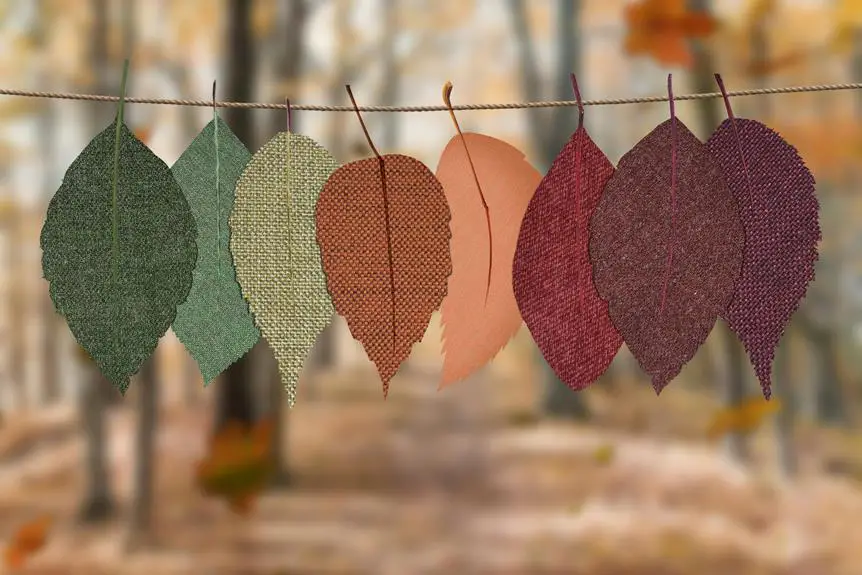When it comes to starching techniques, knowing which fabrics work best can make a significant difference in your results. You might find that cotton, with its durability and range of colors, offers great versatility. On the other hand, pure linen presents a refined finish but needs careful handling. Blends and lightweight synthetics can also yield impressive outcomes. However, the choice of fabric isn't just about appearance; it affects stiffness and texture too. So, what should you consider when selecting the right fabric for your project? The answer might surprise you.
Table of Contents
Key Takeaways
- Cotton fabrics are versatile and absorb starch well, making them ideal for achieving stiffness while retaining flexibility in various projects.
- Linen options, especially pure linen, provide a sophisticated crispness but require careful handling during starching for optimal results.
- Cotton-polyester blends offer a crisp appearance with reduced ironing needs, making them practical for quick projects while still allowing for light starch application.
- Specialty fabrics like cotton blends combine softness with durability, enhancing the effectiveness of starch applications for unique project outcomes.
Cotton Fabrics
When you're choosing fabrics for starching techniques, cotton stands out as a top choice for its natural fibers and ability to hold shape. This versatile material not only provides durability but also offers a crisp finish when starched. Cotton's breathability makes it ideal for various projects, from table linens to clothing.
When working with cotton, you'll appreciate the range of weights and weaves available. Lightweight cotton can create delicate, airy designs, while heavier options provide stability for structured pieces. You'll find that the fabric absorbs starch well, allowing you to achieve the desired stiffness without compromising flexibility.
In addition to its practical benefits, cotton's wide array of colors and patterns makes it a favorite among crafters. You can easily coordinate your chosen fabric with your project's theme or décor. Just remember, the quality of cotton can vary, so opting for higher-grade fabric often yields better results in starching.
Linen Options
Linen offers a unique combination of strength and elegance, making it an excellent choice for starching projects. When you choose linen, you're opting for a fabric that not only holds its shape well but also adds a touch of sophistication to your creations. Its natural fibers absorb starch effectively, giving you crispness without compromising flexibility.
Here's a quick overview of different linen options and their benefits:
| Linen Type | Benefits | Best Uses |
|---|---|---|
| Pure Linen | Highly breathable and strong | Tablecloths, napkins |
| Washed Linen | Softened texture, easy to care | Casual wear, curtains |
| Blended Linen | Combines durability with softness | Upholstery, home decor |
| Textured Linen | Adds visual interest | Accent pieces, fashion items |
When starching linen, ensure you're using the right type for your project. Pure linen provides maximum crispness, while washed linen offers a softer, more relaxed look. Experiment with different starch levels to achieve the desired finish, and you'll find that linen truly elevates your starching endeavors.
Blends and Synthetics
Blends and synthetics offer versatile options for starching, allowing you to achieve various textures and finishes while benefiting from their unique properties.
When you're working with cotton-polyester blends, you'll find that they hold starch well, providing a crisp appearance without becoming overly stiff. This blend is perfect for shirts and table linens, giving you that polished look with less ironing effort.
Synthetic fibers like polyester and nylon are also excellent choices for starching. They're durable, resist wrinkles, and can maintain their shape even after repeated washings. You can easily create a smooth, professional finish on garments and home textiles by applying starch to these fabrics.
Additionally, synthetic blends tend to dry faster, making them convenient for quick projects. However, be cautious with the amount of starch you use, as too much can make these fabrics feel heavy or crunchy. Instead, aim for a light application to enhance the fabric's natural drape while achieving that desired structure.
Specialty Fabrics
When working with specialty fabrics, you'll find that cotton blends hold up well to starching, giving you a crisp finish.
Linen also has unique properties that can enhance your projects, but it requires careful handling to achieve the desired results.
Don't forget about synthetic fabrics, as their compatibility with starch can vary, affecting the outcome of your work.
Cotton Blends and Starching
Cotton blends are popular choices for starching because they combine the softness of cotton with added durability and crispness. When you starch cotton blends, you'll notice that they hold their shape beautifully while still feeling comfortable against your skin. This versatility makes them ideal for a range of projects, from home decor to clothing.
When selecting a cotton blend for starching, look for fabrics that contain a mix of synthetic fibers, like polyester. These blends enhance the fabric's ability to maintain a crisp finish while minimizing wrinkles. You can easily achieve the desired stiffness with varying starch concentrations, depending on your project's needs.
Keep in mind that the weight of the fabric also plays a crucial role in how well it responds to starching. Lightweight blends may require a lighter touch, while heavier ones can tolerate more starch for a standout finish. Always test a small swatch first to ensure you achieve the look you want.
Incorporating cotton blends into your starching techniques can elevate your projects, providing both elegance and practicality for all your fabric needs.
Linen's Unique Properties
Linen offers distinct properties that make it an excellent choice for starching, providing a crisp, structured finish that enhances any project. Its natural fibers are highly absorbent, allowing for even distribution of starch, which ensures your fabric retains its shape and form. When you starch linen, you'll notice that it holds a stiffer texture, creating a polished look that's ideal for table linens, shirts, or curtains.
One of the unique aspects of linen is its breathability. Starching can result in a durable finish without sacrificing the fabric's ability to allow air circulation, making it comfortable to wear or use in different environments. Plus, linen's natural luster and texture add a timeless elegance to any item, elevating your finished piece.
However, keep in mind that linen can wrinkle easily, so be mindful when handling it after starching. To achieve the best results, wash and dry your linen fabric thoroughly before applying starch. This ensures that the fibers are clean and ready to absorb the starch effectively.
Embrace linen's unique properties, and you'll find that it can take your starching projects to the next level.
Synthetic Fabrics Compatibility
Synthetic fabrics can present unique challenges and opportunities when it comes to starching techniques. While these materials, like polyester and nylon, can hold their shape better than natural fibers, they often require special considerations to achieve the desired results. You'll want to pay attention to the specific type of synthetic fabric you're working with, as their responses to starch can vary.
Here are some tips to keep in mind:
- Test First: Always do a small patch test to see how the fabric reacts to starch.
- Choose the Right Starch: Use a starch designed specifically for synthetic fibers to avoid damage.
- Control the Temperature: Avoid high heat when ironing, as it can melt or distort synthetic fabrics.
Choosing the Right Starch
When selecting the right starch, consider your fabric's needs and the desired stiffness for the best results.
Different starches offer varying levels of hold and finish, so you'll want to match the starch to your fabric type. For example, a lightweight cotton might benefit from a light spray starch, giving it a bit of crispness without weighing it down. On the other hand, if you're working with heavier fabrics like canvas, you may want a heavier starch to provide the structure you need.
You should also think about the method of application. Some starches come in aerosol cans for easy use, while others are liquid concentrates that you mix with water. If you're aiming for precision, a liquid starch might be the way to go, allowing you to control the amount you apply.
Additionally, consider any special features you may want, such as scent or wrinkle resistance.
There's no one-size-fits-all solution, so take the time to experiment with different starches to find the perfect match for your project. Your choice will ultimately influence the final look and feel of your fabric.
Tips for Best Results
To achieve the best results with starching techniques, always pre-wash your fabric to remove any finishes that could interfere with starch adhesion. This simple step sets the foundation for a crisp, professional look.
After washing, here's what you should keep in mind:
- Select the Right Starch: Choose a starch that suits your fabric type, whether it's liquid, spray, or powder. Each type offers different levels of stiffness.
- Apply Evenly: Use a spray bottle or brush to ensure an even application of starch. Avoid over-saturating, as it can weigh the fabric down.
- Iron at the Correct Temperature: Check the fabric label for the recommended ironing temperature. Using the right heat will help set the starch effectively.
Frequently Asked Questions
How Do I Store Starched Fabrics to Maintain Stiffness?
To maintain stiffness in starched fabrics, you should store them flat, avoiding folds. Use breathable storage bags, and keep them in a cool, dry place. This prevents moisture and helps retain the desired texture and shape.
Can I Use Homemade Starch Instead of Commercial Products?
Yes, you can use homemade starch instead of commercial products. Just mix cornstarch with water, heat it until thickened, and let it cool. It'll provide stiffness, but results may vary compared to store-bought options.
Is Starch Safe for Delicate or Vintage Fabrics?
Starch can be risky for delicate or vintage fabrics. It may cause stiffness or damage their fibers. You should test a small area first to see how the fabric reacts before proceeding with the entire piece.
How Often Should I Starch My Fabrics for Best Results?
You should starch your fabrics whenever they start losing their crispness, typically after each wash. Regularly applying starch helps maintain a polished appearance, so don't hesitate to refresh them as needed for the best results.
What Is the Difference Between Heavy and Light Starch?
Heavy starch provides a crisp, firm finish, ideal for structured projects, while light starch offers a softer feel, allowing for more flexibility. You'll choose based on the desired look and functionality of your fabric.
- Tetron Fabric for Marine Applications: Durability and Use Cases - June 18, 2025
- Tetron Fabric for Outdoor Furniture: Weather Resistance and Care - June 18, 2025
- Tetron Fabric for Wall Coverings: Style and Application Tips - June 18, 2025







